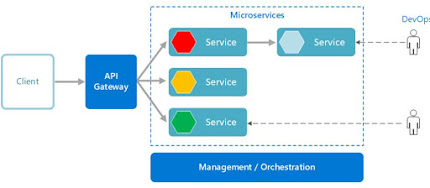A microservice is just a web service. That is a small, well-defined scope and is loosely coupled from any other web service.
Usually, you don't build just one microservice, but rather your organization adopts a microservices architecture that consists of a collection of microservices, each one self-contained and implementing a single business capability.Each service has a separate codebase, which can be managed by a small development team.
In fact, microservices don't even need to share the same technology stack, libraries, or frameworks, which allows each team to choose the right tool for the job.This means that a single development team can build, test, and deploy a service. The result is a continuous innovation and a faster release cadence. Teams can now focus on one service, and with a smaller scope of each service, the code base will be easier to understand, making it easier for new team members to ramp up and to get started.
Going this route now allows each microservice to be deployed independently of every other microservice in the organization. A team can update an existing service without rebuilding and redeploying the entire application. Plus, they can also easily roll back or roll forward and update if something goes wrong. The best part, this makes bug fixes and feature releases more manageable and less risky.The deployment strategy also means that each microservice can be scaled independently.
A benefit of this efficiency is that each microservice is responsible for persisting its own data or external state and not rely on some common repository layer.In fact, some microservice experts insist that each microservice should even have its own separate database.
Again, the idea here is to make each microservice completely autonomous with no cross-dependencies from a business domain perspective. This kind of freedom provides a layer of fault isolation. If a service goes down, it won't necessarily take out the entire application.
Microservices can communicate with each other by using well-defined APIs. The internal implementation details of each service are encapsulated behind their interface. However, typically you'd want to reduce those interdependencies and try to introduce an orchestration or management layer in the higher level consuming application that coordinates calls to various lower level microservices and combines results.
A microservices architecture solves some problems and is more appropriate when you have a large application that requires a high release velocity, you have complex applications that need to be highly scalable,you have applications with rich domains or many sub-domains, you have an organization that consists of small development teams.
microservices is a way to simplify an application architecture by focusing on creating smaller, more manageable, autonomous and independently deployed web services that address a single business domain or capability. A microservices architecture consists of a collection of small, autonomous services. Each service is self-contained and should implement a single business capability.



No comments:
Post a Comment